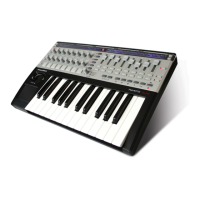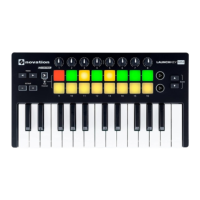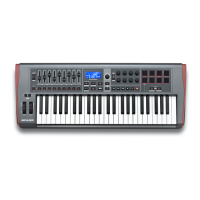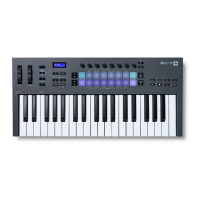28
RE6: Arpeggiator Key Sync
Displayed as: ArpKSync
Initial value: Off
Range of adjustment: Off or On
Arpeggiator Key Sync determines how the sequence behaves when an extra note is played.
When Off, the new note is simply added to the sequence at the appropriate point. When
On, the sequence restarts every time a new note is played. Note that ArpKSync only
applies if LATCH [20] is On.
RE7: Arpeggiator Velocity
Displayed as: ArpVel
Initial value: Off
Range of adjustment: Off or On
When set to On, the note velocities used for each note in the arp sequence will be those
pre-programmed with the pattern. When set to Off, the velocities of the notes as you
play them are used by the Arpeggiator. This lets you include dynamics in the Arpeggiator
sequence.
For Arpeggiator Velocity to work, you need to set AmpVeloc (RE5 in Envelope 1
Menu Page 1) to a value greater than 0, otherwise there will be no variation
in dynamics.
Try assigning Velocity to other parameters in the Modulation Matrix for some
interesting results.
RE8: Tempo clock
Displayed as: ClockBPM
Initial value: 120
Range of adjustment: 40 to 250
This parameter sets the tempo in BPM (Beats Per Minute) on which the arp sequence is
based, when using its internal clock. It also defines the Tempo for all synchronised aspects
of the Patch, thus its setting will be used by the various Sync parameters in the FX and
Sync Menus.
IMPORTANT – If the UltraNova is set to receive an external MIDI clock, the ClockBPM
setting will be ignored. Note also that the displayed value for ClockBPM will remain at its last
‘internal’ value if external sync is selected. See page 38 for more details about external sync.
the chorDer
The UltraNova’s Chorder is a very useful feature which permits you to play chords contain-
ing up to ten notes by pressing a single key. The resulting chord uses the lowest note
played as its bass; all the other notes in the chord will be above the bass.
The two top panel CHORD buttons control the Chorder [21]; ON simply enables or disa-
bles the Chorder function, EDIT opens the Chord Edit Menu.
Programming the chord:
With the Chord Edit Menu open, press the VIEW button [7], (indicated by START on the
display). Its LED will be flashing, but this will go off when the button is pressed, and the
LED in the adjacent USER button (indicated by ACCEPT in the display) will flash instead.
Now play the chord you want to program; you can play it in any key or inversion you wish.
The Chorder will identify the keys being pressed and indicate them in the lower row of the
display, with the lowest note of the chord always showing as a 0. The semitone intervals
of the other notes in the chord will be shown counting from the left. Thus if you play a flat-
tened seventh chord, the display will show:
Now press the USER key to accept your selection. The chorder function can now be ena-
bled by pressing the ON button. You will find that pressing any key on the keyboard now
plays a flattened seventh chord, with the key pressed forming the lowest note of the chord.
Be aware that the semitone intervals displayed are those from the whole twelve-tone scale,
not those from the eight-note tonic sol-fa usually used to describe the notes comprising a
chord – thus the major third in the example above appears as ‘4’ because it is four
semitones above the root, the natural fifth as ‘7’ because it is 7 semitones above, and so on.
Note that the Arpeggiator precedes the Chorder within the UltraNova’s synth
engine. This has the consequence that if both the Arpeggiator and Chorder are in
use, the entire chord resulting from each key press will be arpeggiated.
RE1: Transposition control
Displayed as: Transpose
Initial value: 0
Range of adjustment: -11 to +11
The transposition control is calibrated in semitone intervals, and the pitch of the chord can
be shifted up to 11 semitones, either up or down.
RE2 to RE8: Not used.
effectS (fx)
The UltraNova comes equipped with a comprehensive set of DSP-based effects
processors, which can be applied to both the synth sound and any audio applied to the
UltraNova’s audio inputs.
The FX section comprises five processing “slots”, each of which may be “loaded” with an
FX processor from a pool of devices that includes panning, equalisation, compression,
delay, chorus, distortion, reverb and Gator effects. In addition to the slots, controls are also
provided for global FX parameters like panning, FX level, FX feedback, etc.
The FX Menus are opened with the EFFECT button [18]. Either three or four menu pages
are available, depending whether any slots have been loaded with FX devices. The first
three pages provide controls for panning, FX levels, FX device selection and device rout-
ing, and are constant. The fourth page is the control page for the processing slot currently
selected by the SELECT buttons [10], so if multiple slots are in use, then additional menu
pages can be accessed by using the SELECT buttons.
FX Menu Page 1 – Panning
RE1: not used.
RE2 Pan control
Displayed as: PanPosn
Initial value: 0
Range of adjustment: -64 to +63
This is the main manual pan control and positions the dry (pre-FX) synth sound/Input audio
in the stereo image between outputs 1 and 2, and also between outputs 3 and 4, if they are
in use. Negative values of PanPosn move the sound to the left and positive values to the
right. Note that some FX (e.g. reverb, chorus) are inherently stereo, and these are added
post-panning. Thus if you are using a sound that uses FX such as these, PanPosn will ap-
pear to not entirely localise the sound fully left or right at its extreme settings.
RE3: Pan Rate
Displayed as: PanRate
Initial value: 40
Range of adjustment: 0 to 127
Automatic panning is also possible, and the Pan section has a dedicated sinewave LFO
which controls this. The PanRate parameter controls the LFO frequency, and thus how
rapidly the sound moves between left and right and back again. With a value of 40, the
sound takes approx. 3 seconds to complete a full cycle, and the range of control allows
extremely slow or extremely fast panning.
For the most effective results with Pan Rate, ensure that PanPosn is set 0 (i.e.
centre panning)
RE4: Pan Rate Sync
Displayed as: PanSync
Initial value: Off
Range of adjustment: see table at page 40
Auto-panning rate may synchronised to the internal or external MIDI clock, using a wide
variety of tempos.
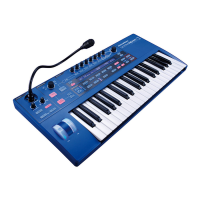
